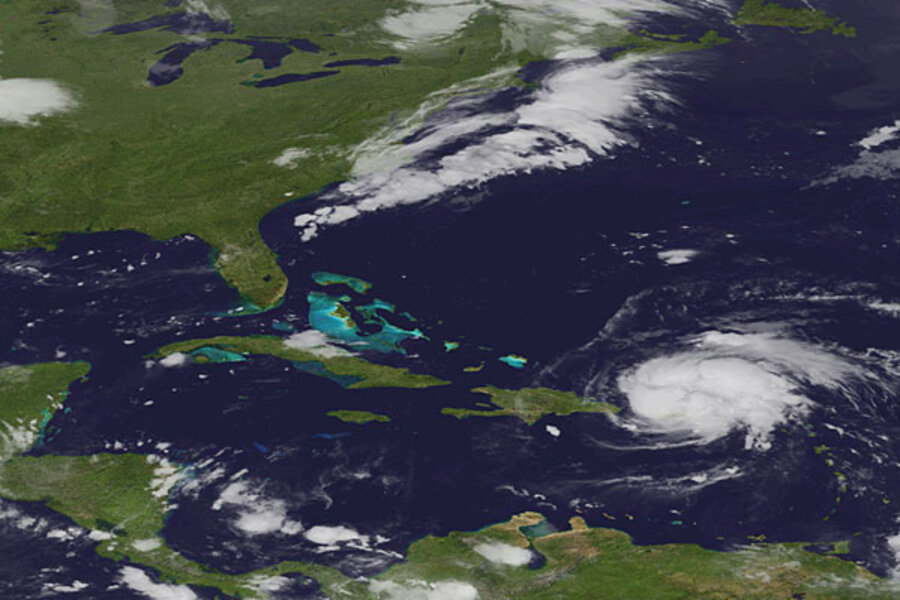Hurricane Irene hammers Puerto Rico, where next?
Loading...
| San Juan, Puerto Rico
Hurricane Irene formed over Puerto Rico early Monday, with maximum sustained winds of 75 miles per hour, becoming the first hurricane of the 2011 season.
The U.S. National Hurricane Center said preliminary reports indicated widespread tree and powerline damage as day broke on the island, with more than 800,000 homes without power.
Doppler weather radar indicated ``winds to near major hurricane strength are now occurring in the higher elevations of the interior mountainous regions'' of the island, it said.
The ninth named storm of the season, Irene remained on a course that could take it to Florida later in the week, NHC forecasters said.
Irene was located about 25 miles west of San Juan and about 125 miles east of Punta Cana in the Dominican Republic as of 5 a.m. EDT.
A hurricane warning was issued for Puerto Rico, Vieques and Culebra and a hurricane watch was issued for the north coast of Haiti from Le Mole, St. Nicholas eastward to The Dominican Republic border and the central Bahamas, the NHC said.
The center of the storm will move off the north coast of Puerto Rico early Monday and move near or over the northern coastal regions of The Dominican Republic later in the day.
``We have to take this seriously,'' Puerto Rico Governor Luis Fortuno said Sunday evening.
Irene was moving west-northwest. It was a large category 1 storm and conditions were deteriorating over northern and eastern Puerto Rico, forecasters said.
The storm was expected to weaken later Monday as it moved over the Dominican Republic, then strengthen again Tuesday as it emerged over water and moved toward the Bahamas.
Irene pelted the Leeward Islands with heavy rain and squalls as it crossed from the Atlantic Ocean into the northeastern Caribbean Sea on Sunday.
Tropical storm watches and warnings were also in effect for all of Haiti, U.S. Virgin Islands, British Virgin Islands, the southeastern Bahamas and the Turks and Caicos islands.
SCHOOLS, GOV'T OFFICES CLOSED
Puerto Rico lifted a ban on Sunday morning shopping, allowing stores to open so residents could stock up on canned food, bottled water and other necessities. Prices were frozen and alcohol sales were halted until after the storm passes.
Schools and government offices were closed for Monday in the U.S. territory of 3.9 million people. Shelters were opened but few people had sought refuge in them by late Sunday.
Fortuno rushed back to Puerto Rico on Sunday from North Carolina, where he was named chairman of the Southern Governors Association. He expressed concern that the storm's erratic path was leading people to ignore its potential harm.
He urged residents in flood zones to go quickly to government storm shelters and those with secure homes to stay inside and off the roads. The island was expected to get up to 10 inches of rain, making driving hazardous.
``This could put your life in danger,'' Fortuno said.
In the Dominican Republic, authorities warned of abnormal waves up to 15 feet high. Weeks of heavy rainfall have already caused deadly flooding in the Dominican Republic and authorities said they may issue evacuation orders for vulnerable areas on Monday.
Residents of the southeastern United States were urged to monitor Irene's progress as the storm headed their way.
Computer forecast models showed Irene moving northwest over the Dominican Republic and then heading toward the Florida peninsula.
Depending on its eventual path and possible turns, Irene might still pose a threat to U.S. oil and gas installations in the Gulf of Mexico, but forecasters say it is too early to predict with certitude.
An early northward turn would bring it near the Georgia-South Carolina coast late in the week but a later turn could take it over central Cuba and into the Gulf of Mexico.
Tropical Storm Harvey hit Belize in Central America Saturday and weakened to a tropical depression as it moved inland. It crossed into Mexico's Bay of Campeche on Sunday and forecasters said it could briefly strengthen back into a tropical storm before hitting the southern coast of Mexico.
Mudslides and flooding could affect agricultural output in Central America, but this year's coffee and sugar harvests are largely complete.
(Reporting by Reuters in San Juan, with additional reporting by Pascal Fletcher and Jane Sutton in Miami and Manuel Jimenez in Santo Domingo; editing by Todd Eastham)





